Last Seen in Havana (Havana Mystery Book 4) a moving, immersive new mystery by Teresa Dovalpage Book Tour with Guest Post and giveaway
A Cuban American woman searches for her long-lost mother and fights to restore a beautiful but crumbling Art Deco home in the heart of Havana in this moving, immersive new mystery, perfect for fans of Of Women and Salt.
Last Seen in Havana
A Havana Mystery Book 4
by Teresa Dovalpage
Genre: Mystery
A
Cuban American woman searches for her long-lost mother and fights to
restore a beautiful but crumbling Art Deco home in the heart of
Havana in this moving, immersive new mystery, perfect for fans of Of
Women and Salt.
Newly
widowed baker Mercedes Spivey flies from Miami to her native Cuba in
2019 to care for her ailing paternal grandmother. Mercedes’s life
has been shaped by loss, beginning with the mysterious unsolved
disappearance of her mother when Mercedes was a little girl.
Returning to Cuba revives Mercedes’s hopes of finding her mother as
she attempts to piece together the few scraps of information
she has. Could her mother still be alive?
Thirty-three
years earlier, in 1986, an American college student with endless
political optimism falls deliriously in love with a handsome Cuban
soldier while on a spontaneous visit to the island. She decides to
stay permanently, but soon discovers that nothing is as it seems
in
Havana.
The two women’s stories proceed in
parallel as Mercedes gets closer to the truth about her mother,
uncovering shocking family secrets in the process . . .
Amazon * Apple * B&N * Google * Kobo * Bookbub * Goodreads
Death Under the Perseids
A Havana Mystery
(Prequel to Last Seen in Havana)
There’s
no such thing as a free cruise in Cuban American author Teresa
Dovalpage's addictively clever new Havana mystery.
Cuban-born
Mercedes Spivey and her American husband, Nolan, win a five-day
cruise to Cuba. Although the circumstances surrounding the prize seem
a little suspicious to Mercedes, Nolan’s current unemployment and
their need to spice up their marriage make the decision a no-brainer.
Once aboard, Mercedes is surprised to see two people she met through
her ex-boyfriend Lorenzo: former University of Havana professor Selfa
Segarra and down-on-his-luck Spanish writer Javier Jurado. Even
stranger: they also received a free cruise.
When Selfa
disappears on their first day at sea, Mercedes and Javier begin to
wonder if their presence on the cruise is more than coincidence.
Mercedes confides her worries to her husband, but he convinces her
that it’s all in her head.
However, when Javier dies
under mysterious circumstances after disembarking in Havana, and
Nolan is nowhere to be found, Mercedes scrambles through the city
looking for him, fearing her suspicions were correct all along.
Amazon * Apple * B&N * Google * Kobo * Bookbub * Goodreads
**Don’t miss the rest of the series!**
Find them on Amazon-
https://www.amazon.com/gp/product/B0881XQZPK
Chapter Two
Last time I
took one of those silly personality tests, the results said I was a
“craftsperson.” Though I don’t believe in online surveys, I had to agree on
that. I like doing things with my hands: repairing furniture, grooming dogs
and, above all, cooking. In fact, it was my job as a chef at La Bakería Cubana
that helped me through a hard, dark time in my life.
La Bakería Cubana had started as a no-frills
bakery in 2010. Nine years later, it had turned into a popular full-fledged
restaurant featured in Bon Appetit. Marlene
Martínez, a former Cuban cop who now lived in Miami, had opened it, and I
partnered with her in 2018.
By
2019, La Bakería Cubana kept me constantly busy. I didn’t date or go out much,
bent on improving my culinary skills. Frankly, coconut candy and guava
cheesecakes sounded more appetizing than any guy I had yet met. I was becoming
what my friend Candela—a capable dog groomer and Tarot reader, all wrapped up
in one quirky entrepreneur—called una ermitaña. She was right. I had
turned into a hermit who lived to cook and eat.
“Unless
you change, the universe will send something to shake you out of your funk,”
she said.
It
did.
In September
2019, a tropical storm warning had been issued for Miami-Dade County. Hurricane
season was in full swing, which always made me nervous. My hands trembled a
little as I took a two-layered chocolate cake out of the oven. A couple had
ordered it whole to celebrate their fiftieth wedding anniversary with their
kids and grandkids. The kitchen was still filled with the fragrance of cocoa
and caramelized sugar when Lila, the waitress, rushed back. The family was so pleased
with the cake that they insisted on congratulating me personally.
“They
are Cubans like you,” Lila said.
The
rain pounded the roof. I wanted to go home before it got worse, but couldn’t
very well say no to our customers.
“It
was the yummiest chocolate cake I’ve had in years,” the matriarch pronounced
when I came to the table. “¡El mejor!”
There
were no crumbs left. Everybody was smiling. It felt like a small, sweet victory
over “the funk.”
“I’m
delighted you all enjoyed it,” I said.
In
a corner, a woman sat alone. Her blond hair was chin-length. Long bangs covered
her forehead, making it difficult to see her face. My heart lurched. I walked
away from the Cubans and approached the woman. Her table had been cleared, and
she was scrolling through her phone.
“May
I—help you?” I stuttered.
She
kept her face down. “I’m just waiting for the check, thanks.”
I
stood there until she looked up with a mix of curiosity and annoyance. She was
in her early forties. Too young. I mumbled an excuse, left the room and broke
into tears upon reaching the safe harbor of the kitchen.
It
wasn’t my mother. Of course it wasn’t. How many times had I been disappointed?
Why did I keep looking for her? I wished to let her go but couldn’t. Her
absence had been a constant and painful presence in my life. Though I was
thirty-one years old, it still hurt.
Short intro: Mercedes and her friend
Candela visit a paladar, a small private restaurant in Havana.
A paladar
La Casa del
Arroz was a small bungalow set in a garden of luscious hydrangea and jasmine
plants. The path to the door was lined by herbs housed in clay pots. It smelled
like saffron, cumin, fried onions and roasted garlic. A tall woman with auburn
hair greeted us warmly.
“Candela,
welcome back! And thanks for bringing company!”
“Hi,
Rosita! This is my friend Mercedes. She’s a chef and will appreciate your
cuisine.”
“Oh,
cool! Do you have a paladar too?”
“Candela’s
flattering me. I work at a restaurant. But I am not a chef, only a self-taught
cook.”
Inside,
the décor was “vintage” with a touch of rustic. A tower of books rested on a
credenza that had a lacquered top. Faded paintings depicted assortments of
apples, grapes and oranges—Candela told me they were called bodegones. A
philodendron sat in a porcelain container surrounded by aloe vera plants in
apothecary jars.
“So
many beautiful things!” Candela said. “So much to explore! I could live in
Havana for a month and not miss home at all.”
“Until
you try to buy fresh fruit and find out there’s none,” I replied. “Then you eat
what’s in the bodegones or go hungry.”
“Oh,
shut up! You’re spoiling it for me.”
Rosita
came to our table. I noticed that she wore a white and purple Santería necklace.
“We’re
lovers of the grain at La Casa del Arroz,” she informed me. “All our dishes are
rice-based or served over rice. I suggest a rice soup with cilantro, basil,
cumin and coconut, to start.”
“It’s
so yummy,” Candela said. “We had it yesterday.”
The
rice soup was creamy and yet light, with a hint of ginger. Similar to a Thai
soup, but the cumin gave it a Cuban twist.
The
main dish, which Candela and I shared, was a big plate of fried rice with
vegetables: regular onions, green onions, garlic, tiny carrots, and bean
sprouts. It came with wheat flour fritters in a sweet and sour sauce. I ordered
another ration to go, for Mamina.
“Full
belly, happy heart,” Candela said, pointing to a sign over the credenza that
read Barriga llena, corazón contento.
I
didn’t think there was any space left for dessert in my barriga, but
when Rosita mentioned the house specialty, rice with mango, Candela said that I
had to try it. It was a bowl of sticky, sweetish rice with generous
mango slices on top.
“There’s
a strong Thai influence here,” she said.
I
nodded, chewing enthusiastically. “This would be a fantastic addition to La
Bakería, but we’ll have to change the name.”
“Why?”
she asked.
“Do
you know what an arroz con mango is, Candela?”
“Duh,
what we just ate.”
“It’s
also an old expression meaning that there’s a big mess. Or something weird.”
She
nodded pensively.
“I’d
say that all this business with your mother and the woman in the blue car is an
arroz con mango then.”
“It
is.”
Religion in Cuba
At some point, when the history of
religion in Cuba is written, there should be a long chapter devoted to the 90s,
considering the number and variety of spiritual trends that flourished at that
time. Until then, the main religion was Catholicism, though there were some
Protestant churches as well. The AfroCuban syncretic religion called Santería
was also widespread but usually practiced in secret.
In the Catholic church that I
attended, the Sagrado Corazón de Jesús Parish, there was only a small youth
group. Most parishioners were older people. Many were retired, so their
participation in religious services didn’t affect negatively their work or social
life.
Few young people openly admitted to
attending church for fear of being accused of “ideological diversion” and
denied certain career choices like psychology or education. It was assumed that
those born after 1959, when the revolution triumphed, should be atheists—or at
least pretend not to have any religious beliefs. I remember scanning the street
before sneaking inside the church, to make sure nobody who could identify me
happened to be around.
But with the fall of the Eastern Bloc
and the economic crisis that ensued in Cuba, prejudices against religion began
to fade. As tourism increased, missionaries started arriving. They were either
people who went with proselytizing intentions or those who simply wanted to
share their religious experiences. And it turned out that often, to their
surprise, young Cubans were very interested in hearing about such experiences,
especially if they were esoteric—the former forbidden fruit.
I remember a Venezuelan lady who
brought dozens of copies of a book entitled Te regalo lo que se te antoje (I
Give You Whatever You Desire) by Connie Méndez, a law-of-attraction sort of
manual. Titles in English came in Americans’ and Canadians’ suitcases. That’s
how I found You Can Heal Your Life by Louise Hay, that made a difference
in my outlook of the world and for sure changed my life. We also heard about
Saint German and the Violet Flame, yoga and theosophy, among other practices
and beliefs.
In the mid-90s, there were at least
twenty New Age groups in Havana. They didn’t need to meet in secret, though
most members didn’t go around proclaiming their activities either. I attended a
few of these groups myself, and they inspired some chapters in my novel Last
Seen in Havana. This is how Mercedes, the protagonist, describes the
headquarters of the Institute of Occult Sciences, which is loosely based on a
real organization:
The living room
was devoid of furniture because the Instituto members sat on cushions and
pillows on the floor. The only decorations were on the walls: a chakra chart
and a psychedelic watercolor of purple and blue triangles inside red circles,
or the other way around. Satia informed me that it was called a mandala and
consisted of sacred geometry.
Mandalas, chakras, sacred geometry…
all those were new concepts in the 90s, at least for young Cubans like me, who
had never traveled out of the island.
I don’t know if any of these groups
stood the pass of time. Hopefully, at some point, someone will delve into the
ramifications of the New Age movement in Cuba and how much influence they
have—if in fact they do—today.
Writer, translator and college professor, Teresa Dovalpage is a Cuban transplant firmly rooted in New Mexico. She is the author of twelve novels, among them the Havana Mystery series, three short story collections and four theater plays. She lives with her husband, one dog and too many barn cats. Her website is http://teredovalpage.com
Website * Facebook * Bookbub * Amazon * Goodreads
Follow the tour HERE for special content and a giveaway!
A hardcover copy of Death under the Perseids,
$10 Amazon giftcard – 1 winner each!


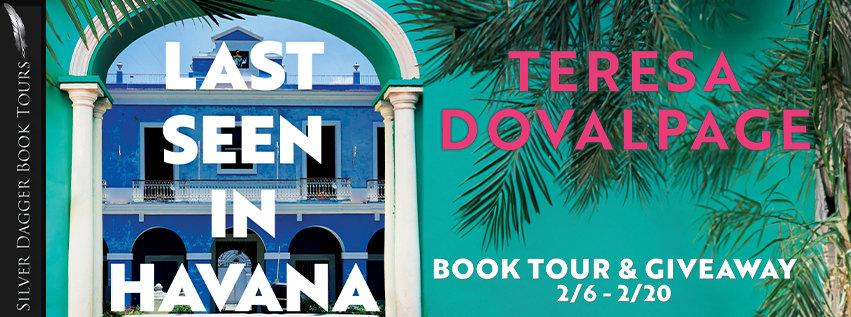
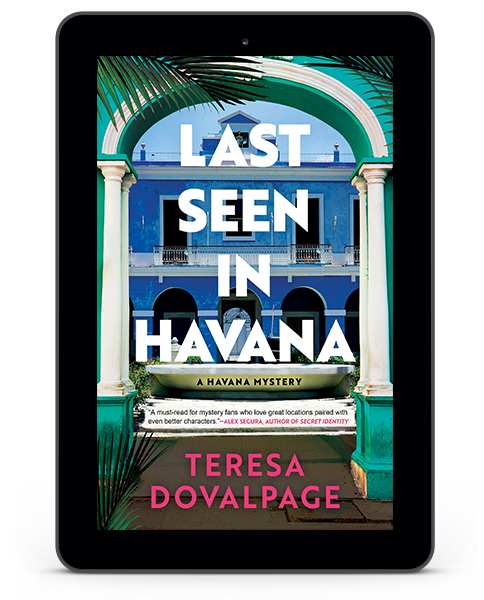
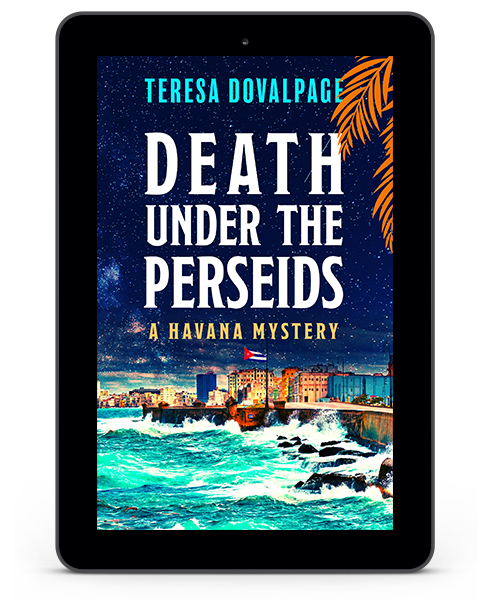
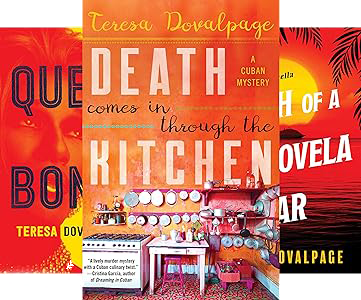



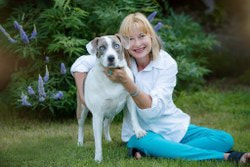


I enjoyed the post. This sounds like a really good mystery series.
ReplyDelete